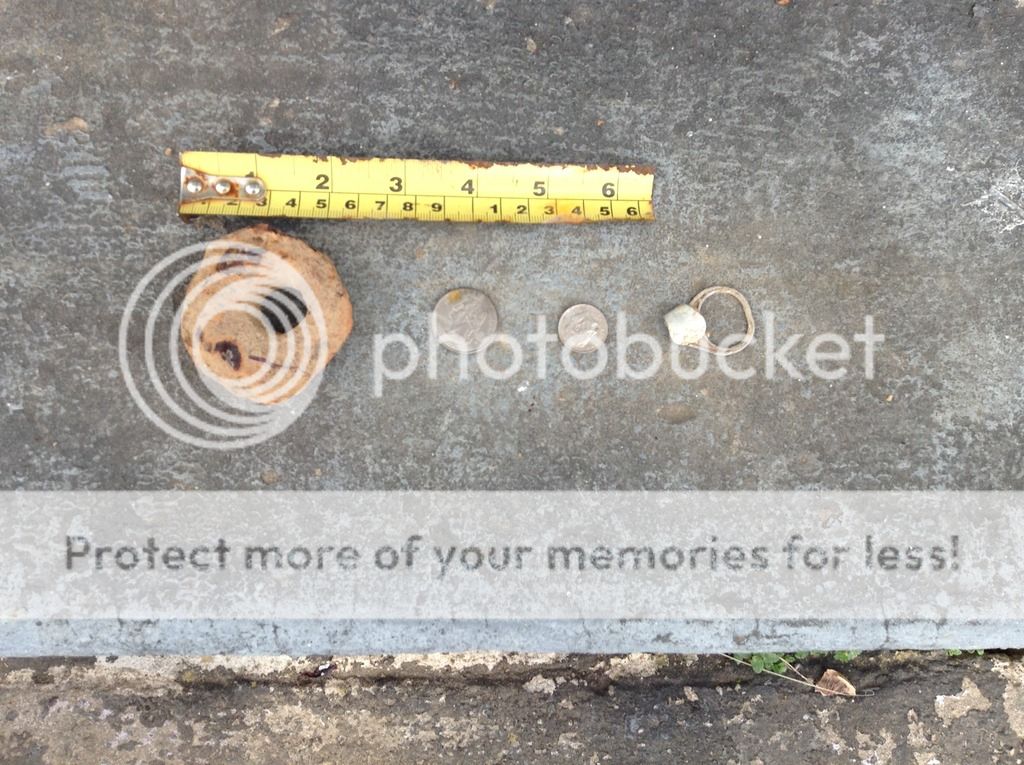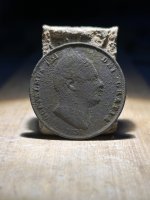tnsharpshooter
Hero Member
- Jul 10, 2012
- 917
- 976
- Detector(s) used
- Xp Deus 2, Xp Deus 1, Minelab Etrac, Minelab Manticore
- Primary Interest:
- All Treasure Hunting
Let's talk overload and overload tone here.
These numbers are using STOCK sized coil.
Btw overload tone is a mild sounding tone, not screeching sounding.
I just checked my unit,,,I used a clad US quarter,,clad US dime,,pull ring (intact), and a pretty good sized piece of iron. Pull ring was also rotated 90 degrees and check,,no real differences noted.
Pic posted below of targets. Ruler in for to show size of iron target.
Checks were accomplished using 2 tone mode,,I did check a few targets even using deep mode gain 97, little difference here noted between 2 tone gain 95 setting. If anything a smidge more distance noted between target and coil for overload signal.
First what I wanted to see is how high I could run the gain,,and still be able to sweep the coil over targets,,,by brushing them,,,so for all practical purposes 0 inches air gap here.
I did check in all frequencies,,and yes there are some differences noted.
After this I checked all targets with what I consider hotter gain settings (95) to see coil height above each target before overload was heard.
This is the first set of numbers,,,coil with 0 clearance/brushing target.
Clad quarter....5khz...overload signal not presented gain had to be 35 or lower
14khz..overload signal not presented gain had to be 52 or lower
20khz..overload signal not presented gain had to be 60 or lower
Clad dime........5khz..overload signal not presented gain had to be 59 or lower
14khz.overload signal not presented gain had to be 97 or lower
20khz. overload signal not presented gain had to be 94 or lower
Pull ring(intact). 5khz overload signal not presented gain had to be 39 or lower
14khz overload signal not presented gain had to be 19 or lower
20khz overload signal not presented gain had to be 19 or lower
Did not check the big piece of iron in this fashion.
Next here are the overload distances from coil using 2 tone gain setting 95
These measurements are approximate in inches.
Quarter......5khz......3/4"
14khz.....1/4"
20 kHz....1/4"
Dime.........5khz.....1/4"
14khz....1/4"
20khz..< 1/8"
Pull ring.....5khz.....1"
14 kHz..1.25"
20 kHz...1.5"
Big iron-- all frequencies provided overload at around 3" distance.

Some overload tone data here using smallest coil,,4x7.5"
Altered targets selection here a bit,,see pic.
Large nail,,smaller nail,bottle cap, bigger ring pull,,big piece of iron, clad quarter and clad dime. Ruler in pic to show size of nails.
Again 2 tone gain at 95.
Distances in inches and are approximate.
Quarter....5khz...1/4"
14khz.1/8"
20khz.1/8"
Dime...... 5khz..1/4"
14khz. 1/8"
20khz. 1/8"
Big ring pull... 5khz..1.5"
14khz. 1.25"
20khz. 1.25"
Bigger nail.... 5khz..1.5"
14khz. 1.25"
20khz. 1"
Smaller nail...5khz...3/4"
14khz..5/8"
20khz.1/2"
Cap...............5khz..1"
14khz..1.25"
20khz.. 1.25"
Big iron piece.... All freqs approx 2.5"
Folks should be able to see,,from reviewing this data,,,5khz not your friend in nails and iron,,20khz is definitely superior. 14khz can provide good results too.
And here, I'm talking from an overload perspective,,,this does carry over to test done with nails and coins,,,same plane,,as well as 3D scenarios,,,and yes it carries over in the field too,,I have witnessed it first hand,,multiple occasions.
These nail readings taken with coil positioned sweeping down the barrel.

These numbers are using STOCK sized coil.
Btw overload tone is a mild sounding tone, not screeching sounding.
I just checked my unit,,,I used a clad US quarter,,clad US dime,,pull ring (intact), and a pretty good sized piece of iron. Pull ring was also rotated 90 degrees and check,,no real differences noted.
Pic posted below of targets. Ruler in for to show size of iron target.
Checks were accomplished using 2 tone mode,,I did check a few targets even using deep mode gain 97, little difference here noted between 2 tone gain 95 setting. If anything a smidge more distance noted between target and coil for overload signal.
First what I wanted to see is how high I could run the gain,,and still be able to sweep the coil over targets,,,by brushing them,,,so for all practical purposes 0 inches air gap here.
I did check in all frequencies,,and yes there are some differences noted.
After this I checked all targets with what I consider hotter gain settings (95) to see coil height above each target before overload was heard.
This is the first set of numbers,,,coil with 0 clearance/brushing target.
Clad quarter....5khz...overload signal not presented gain had to be 35 or lower
14khz..overload signal not presented gain had to be 52 or lower
20khz..overload signal not presented gain had to be 60 or lower
Clad dime........5khz..overload signal not presented gain had to be 59 or lower
14khz.overload signal not presented gain had to be 97 or lower
20khz. overload signal not presented gain had to be 94 or lower
Pull ring(intact). 5khz overload signal not presented gain had to be 39 or lower
14khz overload signal not presented gain had to be 19 or lower
20khz overload signal not presented gain had to be 19 or lower
Did not check the big piece of iron in this fashion.
Next here are the overload distances from coil using 2 tone gain setting 95
These measurements are approximate in inches.
Quarter......5khz......3/4"
14khz.....1/4"
20 kHz....1/4"
Dime.........5khz.....1/4"
14khz....1/4"
20khz..< 1/8"
Pull ring.....5khz.....1"
14 kHz..1.25"
20 kHz...1.5"
Big iron-- all frequencies provided overload at around 3" distance.

Some overload tone data here using smallest coil,,4x7.5"
Altered targets selection here a bit,,see pic.
Large nail,,smaller nail,bottle cap, bigger ring pull,,big piece of iron, clad quarter and clad dime. Ruler in pic to show size of nails.
Again 2 tone gain at 95.
Distances in inches and are approximate.
Quarter....5khz...1/4"
14khz.1/8"
20khz.1/8"
Dime...... 5khz..1/4"
14khz. 1/8"
20khz. 1/8"
Big ring pull... 5khz..1.5"
14khz. 1.25"
20khz. 1.25"
Bigger nail.... 5khz..1.5"
14khz. 1.25"
20khz. 1"
Smaller nail...5khz...3/4"
14khz..5/8"
20khz.1/2"
Cap...............5khz..1"
14khz..1.25"
20khz.. 1.25"
Big iron piece.... All freqs approx 2.5"
Folks should be able to see,,from reviewing this data,,,5khz not your friend in nails and iron,,20khz is definitely superior. 14khz can provide good results too.
And here, I'm talking from an overload perspective,,,this does carry over to test done with nails and coins,,,same plane,,as well as 3D scenarios,,,and yes it carries over in the field too,,I have witnessed it first hand,,multiple occasions.
These nail readings taken with coil positioned sweeping down the barrel.

Amazon Forum Fav 👍
Last edited:




